Like The Photon says, it's the lowest non-zero frequency, it's called the fundamental, and the other harmonics are integer multiples of it. That means the fundamental is the frequency with the longest period in the signal.

This AM signal is the product of two frequencies, a low baseband signal frequency and a higher modulating frequency, which in this case is exactly 10 times the baseband frequency. The signal's period is the lower frequency's period, and its inverse is the fundamental's frequency.
The function is (3 + sin(\$\omega_0\$)) \$\times\$ sin(\$\omega_m\$). Since
\$ sin(x) \times sin(y) = \dfrac{cos(x – y) – cos (x + y)}{2}\$
we have
\$ V_t = 3 \cdot sin(\omega_m t) + \dfrac{cos(\omega_m t - \omega_0 t)}{2} - \dfrac{cos(\omega_m t + \omega_0 t)}{2} \$
and, with \$\omega_m\$ = 10 \$\times\$ \$\omega_0\$
\$ V_t = 3 \cdot sin(10 \cdot \omega_0 t) + \dfrac{cos(9 \cdot \omega_0 t)}{2} - \dfrac{cos(11 \cdot \omega_0 t)}{2} \$
which can be written in the standard Fourier series form:
\$ V_t = -\dfrac{1}{2}sin(9 \cdot \omega_0 t - \dfrac{\pi}{2}) + 3 \mbox{ } sin(10 \cdot \omega_0 t) + \dfrac{1}{2}sin(11 \cdot \omega_0 t - \dfrac{\pi}{2}) \$
For a repeating signal the frequency of the fundamental is greater than zero, and the harmonics show in the spectrum as equal-spaced lines.
For a non-repeating signal the limit of the signal's period goes to \$\infty\$ so that the frequency of the fundamental goes to \$ \displaystyle \lim_{f \to 0} \$, and the series of harmonics forms a continuous spectrum.
I made the following observation in this answer:
"Sometimes it's difficult to see the fundamental sine in it. Take for instance the sum of a 3Hz sine and a 4Hz sine. The resulting waveform will repeat once every second, that's 1Hz. The 1Hz is the fundamental, even if its amplitude is zero. The series can be written as
\$ V_t = 0 \cdot sin(\omega_0 t) + 0 \cdot sin(2 \omega_0 t) + sin(3 \omega_0 t) + sin(4 \omega_0 t)\$
All the following terms also have zero amplitude.
Why is the fundamental frequency 1Hz,and not 0.5Hz, for instance? 3Hz and 4Hz are also multiples of that. The fundamental is the greatest common divider of the composing harmonics, and the GCD of 3 and 4 is 1. If you would choose a lower frequency its period will show a repetition of the signal, twice in the case of 0.5Hz.
A note on GCD
It has been suggested that GCD only applies to integers, like in the given example. GCD can also be applied to the rationals, however. I found that the definition \$ GCD\left(\dfrac{a}{b}, \dfrac{c}{d} \right) = \dfrac{GCD(a\cdot d, c \cdot b)}{b \cdot d} \$ seems to work, and has been confirmed to be the correct method.
Note that also in the AM example the amplitude of the fundamental is zero. The modulated signal only consists of the 9th, 10th and 11th harmonic. GCD(9 \$\omega_0\$, 10 \$\omega_0\$, 11 \$\omega_0\$) = \$\omega_0\$.


